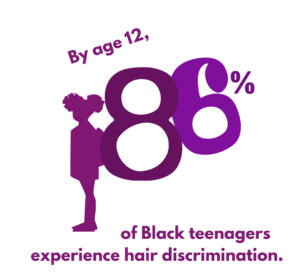
I Am Not My Hair
…And Certainly Not The Discrimination That Comes With It
August 2024
Hair Discrimination in Professional Settings, the CROWN Act, and Implications for Advertising
By: Jaya Wilson and Haniff Murray
What is it, the braids? Well yes, it just might be. Some people may think that hair is trivial or that it is just a function of biology meant to keep us warm and cushion our craniums, but there are huge social and political implications behind the strands of hardened protein flowing from our scalps.
Whether it be braids, a buzzcut, or balding, hair is our natural accessory. It is an extension of how we carry ourselves and is reflective of our culture and personality. It could also potentially represent the mood we woke up in on a particular day or even the week we’ve been having. The way we wear our hair is relative to our freedom, and when policed, it can cause emotional distress.
Historically, American culture has championed Eurocentric hair textures and styles of hair as more acceptable than those of Black people and other people of color; this discriminatory sentiment leaks into academic, career, and life opportunities for people with hair outside of “the standard.” This narrative fuels academic and workplace discrimination for traditionally Black hairstyles, like when Daryl George, a Black high school student, was suspended for over a month due to the length of his locs, or when Chastity Jones had her job offer with Catastrophe Management Solutions rescinded after refusing to cut her locs.
This type of discrimination has become more noticeable and more unmistakable over the past few years and has pushed people to organize and create protections for protective hairstyles and hair by-and-large. On July 3, 2019, the California legislature signed the CROWN Act into law. The CROWN Act celebrates the diversity and beauty of Black hair. It is crucial to ending hair discrimination, ensuring everyone can wear their hair with pride, free from bias and prejudice.

What is Hair Discrimination?
Hair discrimination impacts all people, but especially Black women and girls who wear hairstyles like locs, braids, twists, afros, and other natural hairstyles in schools and workplaces with unfair rules or policies. These policies are typically based on subjective/biased beliefs about what “professional” or “neat” hairstyles look like, often based on Eurocentric standards of beauty for hair textures, styles, and lengths (ex. straight hair). Hair discrimination can occur from the workplace to academia. In workplaces, hair discrimination happens when Black employees are judged, punished, or even fired for how they wear their hair to work. A 2023 study found that black women’s hair is 2.5 times more likely to be perceived as unprofessional, and 54% of them are more likely to feel like they have to wear their hair straight to a job interview in order to be successful. Black women with natural hairstyles are also less likely to land job interviews in the first place because of their hairstyles. Hair discrimination also impacts students in a variety of ways. Some examples include students receiving detentions and suspensions for violating school dress codes which prohibit wearing hair in braids with extensions or other natural hairstyles, student-athletes who are unable to participate in sports unless they cut or change their hair, and displays that show images of Black children, including Black girls with braids, and label those hairstyles as “inappropriate.”
Statistics
According to the ADL

- By age twelve, 86% of Black teenagers started experiencing discrimination based on their hair.
- 81% of Black children in majority-white schools say they sometimes wish their hair was straight.
- A previous study by Dove (in 2019) found that Black women were 1.5 times more likely to be sent home or know of a Black woman sent home from the workplace because of her hair.
- 80% of Black women are more likely to change their hair from its natural state to “fit in” at their place of work.
What is the Crown Act?
The CROWN Act is a law that forbids discrimination based on hair texture and hairstyles, with CROWN standing for: “Create a Respectful and Open Workplace for Natural Hair.” The CROWN Act has been passed in 23 states, including California and New York. In Florida, lawmakers have repeatedly tried to pass legislation to protect natural hair from discrimination. After attempting May 2023, their efforts to pass failed in the judiciary committee.
How does this Affect Advertising?
We advertise to market or sell a product, service, or experience. Advertising has come a long way from its humble origins and today we see dynamic campaigns featuring beautiful cinematography, complex animations, and trained actors all around us. Agencies and art directors should be very intentional and aware of how they represent different cultures on the big screen. As we stray away from the days where ethnic representation was far and few in between, let us make an effort as people and business professionals to portray different types of cultural hairstyles in our work.
It does not have to be the highlight of the advertisement. We do not have to emphasize that we are representing different ethnic styles in a way that may read inauthentic. It can be subtle! Simply having the representation there in an intentional and tasteful way is enough. The average viewer may overlook these efforts, but for the child with long locs that is told he cannot be a professional and wear his cultural hairstyle, seeing someone who looks like him in an advertisement could affirm his confidence. This also means agencies should hire employees who reflect these hairstyles and cultures to create culturally competent media.
So, What’s Next?
There continues to be an ongoing push to pass the CROWN Act in multiple regions of the country. Here’s how you can help:
⇒Push for reform.
No one should have to face natural hair discrimination. Workplaces and institutions should review their appearance policies and remove references to specifically prohibited ethnic hairstyles – talk to managers or unite with colleagues to push for this.
⇒Be an ally.
Whether in schools, social groups, or jobs, be prepared to call out discrimination when you see it. Allyship also means standing in solidarity with those who are affected by discrimination.
⇒Be inclusive.
When making advertising campaigns, consider the portrayal of different ethnic and cultural hairstyles. Large audiences are unlikely to be ethnically homogenous, so the representation we show to them should reflect that.
You can find more information about the CROWN Act at: https://www.thecrownact.com/
The opinions expressed in this article are the writer’s own and do not reflect the views of Ad 2 or AAF.
This article is written by a volunteer writer for Ad 2 Orlando.
